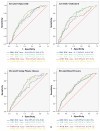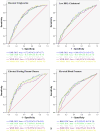Comparison of Waist Circumference, Body Mass Index, Percent Body Fat and Other Measure of Adiposity in Identifying Cardiovascular Disease Risks among Thai Adults
- PMID: 23599834
- PMCID: PMC3627423
- DOI: 10.1016/j.orcp.2008.05.003
Comparison of Waist Circumference, Body Mass Index, Percent Body Fat and Other Measure of Adiposity in Identifying Cardiovascular Disease Risks among Thai Adults
Abstract
Objective: To compare the abilities of body mass index (BMI), percent body fat (%BF), waist circumference (WC), waist-hip ratio (WHR) and waist-height ratio (WHtR) to identify cardiovascular disease risk factors.
Methods: This cross-sectional study is comprised of 1,391 Thai participants (451 men and 940 women) receiving annual health check-ups. Spearman's rank correlation was used to determine the association of the five anthropometric indices with metabolic parameters including fasting plasma glucose, triglyceride, high density lipoprotein and blood pressure. The prevalence of cardiovascular disease risk factors was determined according to tertile of each anthropometric measure. Receiver operating characteristic (ROC) curves were plotted to compare anthropometric measure as predictors of the prevalence of cardiovascular risk factors.
Results: Metabolic parameters were more strongly associated with %BF and WHR and least correlated with BMI in men. Among women, BMI was most strongly correlated with metabolic parameters. In both genders, the prevalence of cardiovascular disease risk factors increased across successive tertiles for each anthropometric measure. Review of ROC curves indicated that %BF and WHR performed slightly better than other measures in identifying differences in CVD risk factors among men. BMI performed at least as well or better than other measures of adiposity among women.
Conclusions: These findings confirm high correlations between anthropometric measures and metabolic parameters. BMI, WC and other measures were not materially different in identifying cardiovascular disease risk factors. Although small differences were observed, the magnitudes of those differences are not likely to be of public health or clinical significance.
Keywords: Body Fat; Body Mass Index; Cardiovascular Risk Factors; Epidemiology; Waist Circumference; Waist-Height Ratio; Waist-Hip Ratio.
Figures


References
-
- World Health Organization. Obesity and overweight. Geneva, Switzerland: World Health Organization; 2006.
-
- Bureau of Health Policy and Plan, Office of Permanent Secretary, Ministry of Public Health. Thailand Health Profile 1997–1998. Bangkok: Printing Press, Express Transportation Organization; 2000.
-
- Vazquez G, Duval S, Jacobs DR, Jr, Silventoinen K. Comparison of Body Mass Index, Waist Circumference, and Waist/Hip Ratio in Predicting Incident Diabetes: A Meta-Analysis. Epidemiol Rev. 2007;29:115–28. - PubMed
-
- WHO Expert Consultation. Appropriate body-mass index for Asian populations and its implications for policy and intervention strategies. Lancet. 2004;363:157–63. - PubMed
-
- Bei-Fan Z. Predictive values of body mass index and waist circumference for risk factors of certain related diseases in Chinese adults: study on optimal cut-off points of body mass index and waist circumference in Chinese adults. Asia Pac J Clin Nutr. 2002;11 (Suppl 8):S685–93. - PubMed
Grants and funding
LinkOut - more resources
Full Text Sources
Miscellaneous
